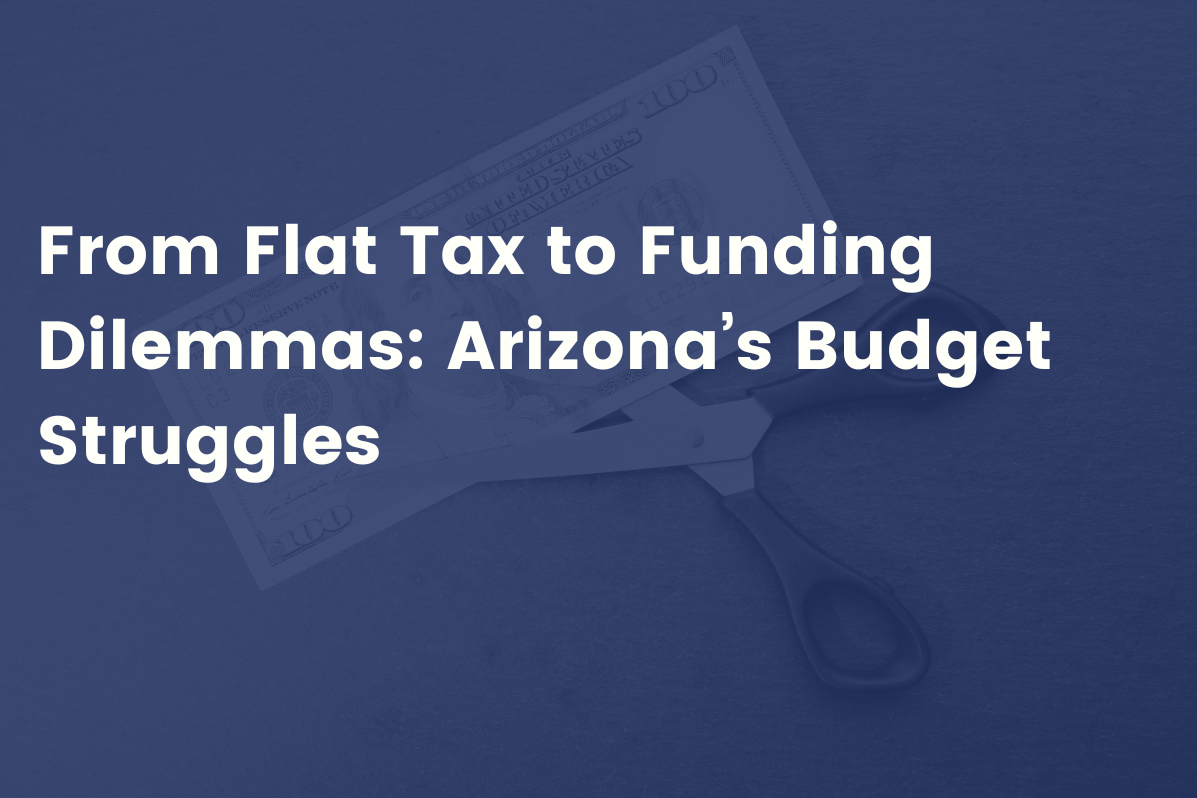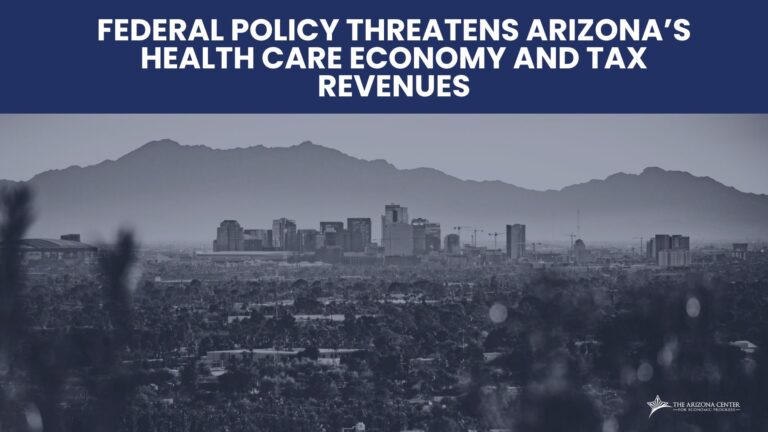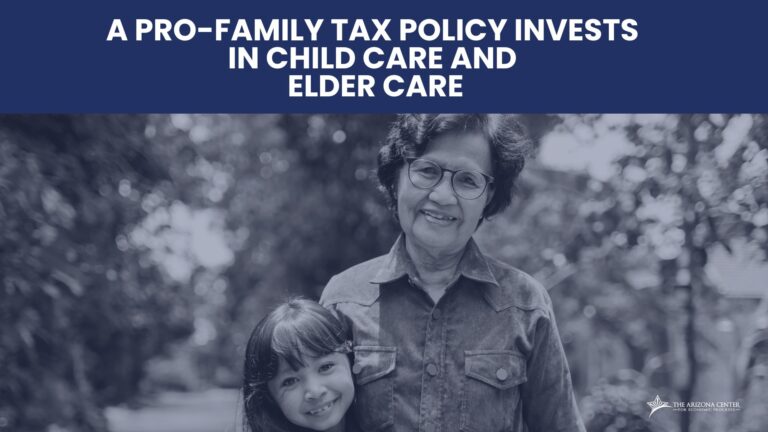
From Flat Tax to Funding Dilemmas: Arizona’s Budget Struggles
Working late into the night on a Saturday, the state legislature passed legislation to resolve an almost $1.6 billion deficit for fiscal years 2024 and 2025. The state found itself in this dire predicament after it learned in January that revenues would be far below initial projections, largely driven by a decline in personal income tax revenue after a flat tax was enacted in 2021.
The legislature, through a bipartisan effort with Governor Hobbs, drafted and passed a balanced budget that found some additional funds for programs that support Arizona’s children and families. However, the budget overall reflected a lack of determined investment in Arizona’s future.
In the finalized budget, we saw a decline in investment in education, housing, and water and transportation infrastructure. Additionally, we saw the transition of funding for many programs go from ongoing to one-time. This means that the legislature will need to debate each year whether funds are available for things like the Healthy Families program, the opportunity weight for schools in high-poverty areas, and adult workforce training programs.
Shockingly, the need for reductions in year-over-year spending is coming at a time when the Arizona economy is showing strong growth. In fact, state officials had to cut spending despite Arizona’s low unemployment rate, increase in personal incomes, and growth in real gross domestic product.
This session should have been the time to affirm Arizona’s commitment to its future. Instead, lawmakers are transferring funds, reducing prior appropriations, and implementing other budget tricks to resolve the revenue shortfall.
This year’s analysis of the budget considers how policymakers traded off investing in Arizona’s future for the adoption of a flat tax.
Education
Arizona undertook a concerted effort to fund K-12 education and adult workforce training programs in fiscal years 2023 and 2024. The latest budget severely slows down the progress made in prior legislative sessions, though the legislature and Governor Hobbs should receive credit for avoiding severe cuts.
Deprioritizes opportunity weight from ongoing to one-time
Two years ago, the state created an opportunity weight to direct more state resources to districts with higher shares of students experiencing poverty. Beginning fiscal year 2025, this opportunity weight has been moved from ongoing to one-time, which means there is a risk that it will not be included in the budget for fiscal year 2026 if revenues continue to fall.
Moves adult workforce programs from ongoing to one-time
The budget shifts workforce education and workforce training programs from ongoing to one-time, beginning in fiscal year 2025. These programs, such as Continuing High School Workforce and Training Program and Community College Adult Education Workforce Training Program, help adult learners attain high school diplomas, industry-recognized credentials, and community college degrees. Additionally, such programs are targeted at individuals who may have had limited educational opportunities due to educational disadvantages, disabilities, or other barriers to education, such as lack of transportation, child care, or food insecurity. Based on 2022 data, those who attain a high school diploma earn 25 percent more per week than those without a high school diploma.
Reduces year-over-year investment for Teachers Academy
Despite Arizona experiencing a multi-year teacher shortage, the budget provided only $1 million in one-time funding to the Teachers Academy as compared to $15 million in one-time funding last year. While additional funding for this program is a small win during a time of budget cuts, the decrease of such funding to $1 million is inadequate given the dire need for additional teachers in Arizona. The program not only assists Arizona college students to afford tuition but provides a necessary pipeline of teachers to staff Arizona public schools.
Institutes minor reform for Empowerment Scholarship Accounts (ESAs)
This budget makes small reforms to the ESA program that are expected to save the state $2.5 million. These reforms fall severely short of what is necessary to rein in a program that continually exceeds cost projections. A recent report by the Brookings Institution highlighted that ESA funds tend to be utilized by children located in affluent zip codes. The positive correlation between ESA participation and income is concerning and suggests that ESAs primarily benefit those with the greatest ability to pay for private school tuition. Until Arizona has a better understanding of its revenue outlook, reforms should be made to ESAs, such as building more transparency, accountability, and common-sense limitations on the program.
Temporarily lifts the Aggregate Expenditure Limit (AEL)
A clear highlight of the budget is that the legislature lifted the Aggregate Expenditure Limit (AEL) for the school year 2024-2025. Had the legislature not lifted the spending cap, then schools would have been prevented from spending their approved budgets. Furthermore, the lifting of the AEL is only a temporary fix. It will need to occur every year until the Arizona electorate, through an initiative, or the legislature, through a referral, puts on the ballot an amendment to the constitution to rescind the spending cap. A permanent solution is necessary, including revisions to an outdated formula from the 1980s that no longer adequately computes the current costs of education.
Fails to extend Proposition 123
Basic state aid (or equalization assistance) is the state funding provided to K-12 school districts that do not collect enough funding from local property taxes to ensure an equal amount is spent on each student in Arizona.
Since 2016, public schools have received an increase of 6.9 percent in funding from the state land trust distribution directed to basic state aid. This meant K-12 education was estimated to receive about $343 million for basic state aid instead of $72 million last year had distribution remained at 2.5 percent. The current budget assumes Prop. 123 will not be extended so $300 million in General Fund dollars have been allocated to cover the K-12 education. This places K-12 education spending at 47 percent of total General Fund spending and closer to Prop.123 triggers for fiscal year 2025. K-12 spending was at 43 percent in the prior year. Had Prop. 123 been referred for extension, there would have been nearly $300 million more to spend on public schools.
Economic well-being
Despite limited funding, this year’s budget provided a few investments that help improve the economic well-being of people, children, and families. At the same time, it also deprioritized key programs – moving funding from ongoing to one-time.
Invests in school meals for students
Beginning January 2023, Arizona used $6.75 million federal dollars to waive the reduced-price fee for school meals through the 2023-2024 school year. This investment in children and families has provided about 12 million school meals to families. With federal funding expiring in June 2024, the budget has appropriated $3.8 million in one-time funding to continue covering school meals for students with low incomes who go to schools where free meal programs are not available. While this is a historic first-time use of General Fund dollars, Arizona should make this a permanent ongoing priority.
Makes overdue investment in child care
This year’s budget appropriates $12 million in one-time funding to child care. Arizona has faced a child care crisis due to prolonged lack of investment, compounded by the expiration of federal funds that stabilized the system during the pandemic. Arizona had not invested General Fund dollars in traditional child care since 2015 when it appropriated $4 million. While this is an investment in the right direction, we are still far behind the highest General Fund investment in child care of $84.5 million in 2008, and the child care system requires additional funding to stabilize.
Adds appropriation to Housing Trust Fund
For the past two years, the state deposited $40 million and $150 million to the Housing Trust Fund, respectively. This year, only after last minute negotiations, Arizona allocated $15 million in one-time funding for affordable housing. Arizona’s Housing Trust Fund helps make housing more affordable by providing direct assistance to people and investing in building affordable housing. In Arizona, there is one affordable and available rental home for every four extremely low-income renter households. Data from the Maricopa Association of Governments confirms that, in the Phoenix-Mesa-Chandler Metropolitan Area, availability of apartment units with rent under $1,000 have dropped from over 90 percent in 2010 to only 6 percent as of June 2023 – a stunning change of circumstances for families. A lack of affordable housing may cost the U.S. economy as much as $2 trillion a year. If Arizona wants to remain economically competitive, we must invest much more in affordable housing on an ongoing basis.
Funds successful program keeping families together but fails to prioritize continued support
The final budget funded Arizona’s Healthy Families program but switched the funding from ongoing to a one-time allocation of $12.5 million. Healthy Families is an evidence-based program that provides services to children less than 5 years of age and members of their families. The program is designed to prevent child abuse or neglect and promote child development and wellness. Healthy Families helps link families with community services and provides child development, nutrition, and safety education. Ongoing funding for the Healthy Families program was restored in 2023 after the program was cut in 2009 due to the Great Recession. Such evidence-based programs have been shown to increase the household incomes of families that participate and may lead to a reduced incidence in Child Protective Services intervention.
State revenues
Given the budget predicament, policymakers had the opportunity to reverse or reform prior irresponsible tax cuts. Nonetheless, aside from a modest, but necessary, cap to the student tuition organization (STO) credit for corporate contributions, the legislature failed to take any additional action to address Arizona’s revenue outlook. This lack of action means we can expect to continue to see large budget deficits in the near future, even as Arizona’s economy is strong.
Sets STO cap for corporate contributions
Student tuiton organizations (STOS) use contributions received from individuals or corporations to award scholarships to students attending private schools. Unlike individual income tax contributions to STOs, which are capped for each person or couple filing jointly, corporate contributions are capped in the aggregate.
This year’s budget provides a modest measure to reform the student tuition organization (STO) tax credit for corporate taxpayers by reducing the cap on the total amount of credits to a set $135 million amount. Previously, the STO cap for corporations was set to increase based on inflation. This means the current cap of $158 million would have otherwise increased to $167 million in fiscal year 2025. Setting this STO cap to a hard $135 million will keep $31.7 million General Fund dollars from going to corporations for fiscal year 2025 – increasing to $35.4 and $39 million for fiscal years 2026 and 2027. This STO cap makes our state’s tax code slightly less regressive.



